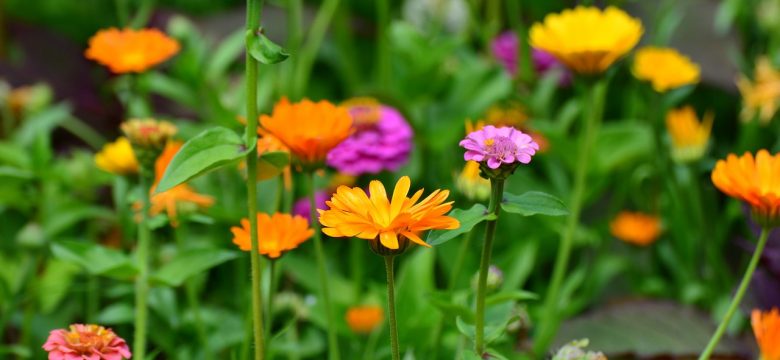Marigolds are a versatile and beneficial addition to any garden. Not only are they beautiful flowers, but they also serve as excellent companion plants. By strategically planting marigolds in your garden, you can take advantage of their natural abilities to repel pests, attract beneficial insects, and improve soil health. Here are five ways to use marigolds effectively in your garden:
- Natural Pest Control: Marigolds emit a strong scent that repels many common garden pests, such as aphids, nematodes, and whiteflies. By planting marigolds alongside vulnerable crops, you can help protect them from insect damage.
- Attracting Beneficial Insects: Marigolds produce nectar-rich flowers that attract beneficial insects like ladybugs, lacewings, and hoverflies. These insects feed on garden pests and help maintain a healthy ecosystem in your garden.
- Planting Marigolds with Vegetables: Interplant marigolds with vegetables like tomatoes, peppers, and cucumbers to deter pests and attract beneficial insects. This companion planting technique can lead to healthier, more productive crops.
- Marigolds for Tomato Health: Marigolds are particularly beneficial when planted near tomatoes. They repel nematodes, which can cause damage to tomato roots, and also attract pollinators that enhance fruit set.
- Marigolds for Pest Control: Plant marigolds near brassicas, such as cabbage and broccoli, to deter common pests like cabbage worms and aphids. The strong scent of marigolds confuses and repels these insects.
By incorporating marigolds into your garden, you can enjoy their vibrant blooms while reaping the benefits of natural pest control, attracting beneficial insects, and improving soil health. Whether you’re a seasoned gardener or just starting out, marigolds are a valuable addition to any garden.
Natural Pest Control
Marigolds are not just beautiful flowers, but they also serve as excellent companion plants in the garden. One of their most valuable attributes is their ability to act as natural pest control. These vibrant flowers emit a strong scent that repels many common garden pests, including aphids, nematodes, and whiteflies. By planting marigolds alongside vulnerable crops, you can provide an effective barrier against insect damage.
The strong scent of marigolds acts as a deterrent to pests, making them less likely to infest your plants. This natural pest control method is not only effective but also environmentally friendly, as it reduces the need for harmful chemical pesticides. Marigolds can be particularly beneficial when planted alongside vegetables like tomatoes, peppers, and cucumbers, which are often targeted by pests. By interplanting marigolds with these vegetables, you can create a natural defense system that helps protect your crops.
Attracting Beneficial Insects
Marigolds are not only beautiful flowers but also serve an important role in attracting beneficial insects to your garden. These insects, such as ladybugs, lacewings, and hoverflies, are natural predators of garden pests and can help maintain a healthy ecosystem in your garden.
One of the reasons marigolds are so effective at attracting beneficial insects is because they produce nectar-rich flowers. These flowers act as a food source for these insects, encouraging them to stay in your garden and continue their pest control duties. By planting marigolds strategically throughout your garden, you can create a welcoming environment for these helpful insects.
Beneficial insects like ladybugs feed on pests like aphids, which can cause damage to your plants. By attracting these insects to your garden, you can reduce the need for harmful chemical pesticides and rely on natural pest control methods instead. This not only benefits your plants but also helps to maintain a more sustainable and environmentally-friendly garden.
To maximize the benefits of marigolds in attracting beneficial insects, consider planting different varieties of marigolds with varying colors and scents. This will attract a diverse range of beneficial insects and create a visually appealing garden at the same time.
Overall, using marigolds to attract beneficial insects is a simple and effective way to maintain a healthy ecosystem in your garden. By providing a food source for these insects, you can encourage them to stay and help control pests naturally, reducing the need for harmful chemicals and promoting a more sustainable approach to gardening.
Planting Marigolds with Vegetables
When it comes to planting marigolds in your vegetable garden, it’s all about using them as companion plants to reap the benefits. By interplanting marigolds with vegetables like tomatoes, peppers, and cucumbers, you can effectively deter pests and attract beneficial insects, resulting in healthier and more productive crops.
Companion planting marigolds with vegetables serves as a natural pest control method. The strong scent of marigolds repels common garden pests such as aphids, nematodes, and whiteflies, keeping them away from your vulnerable crops. This helps protect your vegetables from insect damage and reduces the need for chemical pesticides.
Additionally, marigolds produce nectar-rich flowers that attract beneficial insects like ladybugs, lacewings, and hoverflies. These insects feed on garden pests, acting as natural predators and maintaining a healthy ecosystem in your garden. By planting marigolds alongside your vegetables, you create an inviting environment for these beneficial insects, further enhancing pest control.
Furthermore, companion planting marigolds with vegetables can improve soil health. Marigolds have the ability to suppress certain soil-borne pathogens and nematodes, which can cause diseases and damage to plant roots. By incorporating marigolds into your crop rotation or using them as cover crops, you can break disease cycles and improve overall soil fertility.
In summary, planting marigolds with vegetables is a valuable companion planting technique that offers multiple benefits. It helps deter pests, attract beneficial insects, and improve soil health, leading to healthier and more productive crops. By incorporating marigolds strategically in your vegetable garden, you can create a harmonious and thriving ecosystem.
Marigolds for Tomato Health
When it comes to growing healthy and productive tomatoes, marigolds can be your secret weapon. These vibrant flowers offer multiple benefits when planted near tomato plants. One of the key advantages is their ability to repel nematodes, which are microscopic worms that can cause damage to tomato roots. By planting marigolds alongside your tomatoes, you create a natural barrier that helps protect the roots from these harmful pests.
But that’s not all – marigolds also attract pollinators that play a crucial role in enhancing fruit set. Pollinators like bees and butterflies are drawn to the nectar-rich flowers of marigolds, and as they visit these flowers, they inadvertently transfer pollen from one tomato flower to another. This process, known as pollination, is essential for the development of healthy and abundant fruits.
So, by incorporating marigolds into your tomato garden, you not only safeguard your plants from nematode damage but also boost their overall productivity. It’s a win-win situation that adds both beauty and functionality to your garden.
Marigolds for Pest Control
Marigolds are not only beautiful flowers, but they also serve as excellent companion plants in the garden. One of the ways marigolds can be used effectively is for pest control. By planting marigolds near brassicas, such as cabbage and broccoli, you can deter common pests like cabbage worms and aphids.
The strong scent of marigolds confuses and repels these insects, making them less likely to infest your brassicas. This natural pest control method can help protect your crops without the need for harmful chemicals. By incorporating marigolds into your garden, you can create a healthier and more pest-resistant environment for your plants.
Marigolds for Soil Health
Marigolds are not just beautiful flowers, but they also have incredible benefits for soil health. These vibrant plants have a natural ability to suppress soil-borne pathogens and nematodes, which can be harmful to other crops. By planting marigolds as cover crops or incorporating them into crop rotation, you can effectively break disease cycles and improve the overall fertility of your soil.
When marigolds are grown as cover crops, their extensive root systems help to loosen compacted soil and improve its structure. This allows for better water infiltration and nutrient absorption, creating an optimal environment for other plants to thrive. Additionally, marigolds release certain compounds into the soil that have been found to inhibit the growth of harmful pathogens, reducing the risk of diseases in your garden.
Another way to utilize marigolds for soil health is by incorporating them into crop rotation. By planting marigolds in between different crops, you can disrupt the life cycles of pests and diseases that specifically target certain plants. This break in the cycle helps to reduce the population of harmful organisms and prevent the build-up of soil-borne diseases over time.
Overall, marigolds are a valuable asset for maintaining healthy soil in your garden. Their natural abilities to suppress pathogens and nematodes, as well as their contribution to improving soil structure, make them an excellent choice for any gardener looking to enhance the health and productivity of their plants.
Companion Planting Tips
Companion planting is a gardening technique that involves planting different plants together to maximize their benefits and create a harmonious ecosystem. When it comes to using marigolds as companion plants, there are a few tips to keep in mind to ensure you get the most out of these beautiful flowers.
First and foremost, choose marigold varieties with strong scents and vibrant colors. The strong scent of marigolds is what helps repel pests and attract beneficial insects. Some popular marigold varieties for companion planting include French marigolds, African marigolds, and signet marigolds. Each variety offers unique characteristics and benefits, so choose the ones that best suit your garden’s needs.
Once you have selected your marigold varieties, it’s important to plant them strategically throughout your garden. Consider placing them near vulnerable crops or in areas where pests are known to be a problem. This will help deter pests and protect your plants from insect damage.
In addition to planting marigolds strategically, you can also consider companion planting with other compatible plants for even greater benefits. Some plants that pair well with marigolds include basil, mint, and calendula. These plants can enhance the pest-repelling and soil-improving properties of marigolds, creating a more robust and healthy garden.
By following these companion planting tips, you can maximize the benefits of marigolds in your garden. Choose the right varieties, plant them strategically, and consider companion planting with other compatible plants. Your garden will not only be beautiful but also healthy and thriving.
Marigold Varieties to Consider
When it comes to companion planting with marigolds, there are several popular varieties to consider. These marigold varieties not only add beauty to your garden but also provide unique characteristics and benefits that can enhance your overall gardening experience.
One popular choice is the French marigold (Tagetes patula). This variety is known for its compact size and vibrant colors, which make it a great choice for adding a splash of color to your garden. French marigolds are also known for their strong scent, which helps repel pests and attract beneficial insects.
Another option is the African marigold (Tagetes erecta). These marigolds are larger in size and produce big, bold flowers in a variety of colors. African marigolds are known for their long-lasting blooms and their ability to attract pollinators like bees and butterflies.
Lastly, there are signet marigolds (Tagetes tenuifolia). These marigolds are smaller in size and have delicate, lacy foliage. Signet marigolds are often used as edging plants or in containers, and they are known for their edible flowers that add a unique flavor to salads and other dishes.
Each variety of marigold offers its own set of characteristics and benefits. Whether you choose French marigolds, African marigolds, or signet marigolds, you can enjoy the beauty and functionality of these companion plants in your garden.
Companion Plants for Marigolds
When considering companion plants for marigolds, there are several options that can enhance the pest-repelling and soil-improving properties of these beautiful flowers. Basil, mint, and calendula are three excellent choices to plant alongside marigolds in your garden.
Basil: Planting basil near marigolds can help deter pests such as mosquitoes and flies. The strong aroma of basil acts as a natural repellent, keeping these unwanted insects away from your garden. Additionally, basil can attract beneficial insects like bees and butterflies, which can aid in pollination.
Mint: Mint is another great companion plant for marigolds. Its strong scent can repel pests like ants and aphids, protecting your garden from potential damage. Mint also has the ability to attract predatory insects like hoverflies and parasitic wasps, which can help control garden pests.
Calendula: Planting calendula alongside marigolds can provide additional benefits to your garden. Calendula flowers attract pollinators like bees and butterflies, ensuring better fruit set in nearby plants. Calendula also has natural anti-fungal properties, which can help prevent soil-borne diseases and improve overall soil health.
By incorporating these companion plants with marigolds, you can create a harmonious and beneficial environment in your garden. The combination of marigolds, basil, mint, and calendula can help repel pests, attract beneficial insects, and improve soil health, resulting in a thriving and productive garden.
Remember to adjust the number of subheadings and their hierarchy according to the requirements of your article or publication.
When writing an article, it is important to consider the specific requirements of your publication or target audience. This includes adjusting the number of subheadings and their hierarchy to best suit the content and structure of your article. By doing so, you can ensure that your article is organized and easy to follow for readers.
Start by determining the main topics or sections that you want to cover in your article. These will serve as your subheadings. Depending on the depth and breadth of each topic, you may need to create additional subheadings within each section to provide more detailed information.
Using hierarchies in your subheadings can help organize your content and make it easier for readers to navigate. For example, you can use the
tag for main subheadings,
for sub-subheadings, and so on. This creates a clear hierarchy that visually separates different levels of information.
If a subheading covers a broad scope, consider breaking it down into smaller subheadings using the
tag. This allows you to provide more specific information and maintain a logical flow within your article.
In addition to using subheadings, you can also use tables and lists to present information in a clear and concise manner. Tables can be used to compare different aspects or provide a visual representation of data. Lists, on the other hand, can be used to highlight key points or steps.
Remember, the goal is to create an article that is well-structured, easy to read, and provides valuable information to your readers. By adjusting the number of subheadings and their hierarchy according to the requirements of your article or publication, you can ensure that your content is organized and engaging.
Frequently Asked Questions
- Q: How do marigolds repel pests?
- Q: What beneficial insects do marigolds attract?
- Q: How can I use marigolds with vegetables?
- Q: Are marigolds beneficial for tomato plants?
- Q: Can marigolds help control pests on brassicas?
- Q: How do marigolds improve soil health?
- Q: What are some companion plants for marigolds?
A: Marigolds emit a strong scent that repels many common garden pests, such as aphids, nematodes, and whiteflies. Planting marigolds alongside vulnerable crops can help protect them from insect damage.
A: Marigolds produce nectar-rich flowers that attract beneficial insects like ladybugs, lacewings, and hoverflies. These insects feed on garden pests and help maintain a healthy ecosystem in your garden.
A: Interplant marigolds with vegetables like tomatoes, peppers, and cucumbers to deter pests and attract beneficial insects. This companion planting technique can lead to healthier, more productive crops.
A: Yes, marigolds are particularly beneficial when planted near tomatoes. They repel nematodes, which can cause damage to tomato roots, and also attract pollinators that enhance fruit set.
A: Absolutely! Planting marigolds near brassicas, such as cabbage and broccoli, can deter common pests like cabbage worms and aphids. The strong scent of marigolds confuses and repels these insects.
A: Marigolds have a natural ability to suppress certain soil-borne pathogens and nematodes, improving soil health. Planting marigolds as cover crops or in crop rotation can help break disease cycles and improve overall soil fertility.
A: Consider planting marigolds alongside other beneficial companion plants like basil, mint, or calendula. These plants can enhance the pest-repelling and soil-improving properties of marigolds.





